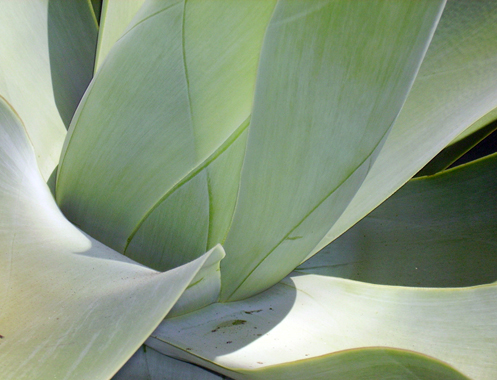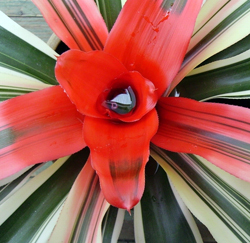Berkeleyan
 Succulent, Big Sur (Rita Gardner) |
A natural talent
Be it with camera or paintbrush, Administration's Rita Gardner gets the picture
![]()
| 21 August 2008
Growing up, Rita Gardner could see objects only at close range. The current executive assistant to Vice Chancellor for Administration Nathan Brostrom was extremely nearsighted, a condition that went undetected until she was 12.
It’s not surprising, then, that in her photography Gardner tends to focus on the micro. On the walls above her desk in California Hall she displays photos she’s taken: Shadows and sun play across the pale-green leaves of a large succulent she snapped up-close in Big Sur. Pink, yellow, and orange tulips are visible against a window. A dewdrop rests in the red interior leaves of a bromeliad that fills the frame.
 Rita Gardner |
Gardner says she’s intrigued by the interplay between positive and negative space. “The background is often as relevant as the foreground,” she says. Odd angles and shapes attract her, as do “the fleeting moments when something is backlit by the sun, or when a dewdrop is caught like a jewel.” A long curl of peeling paint can be just as interesting as a pattern found in nature: “Decay has its own beauty,” observes Gardner.
A boyfriend gave Gardner an Olympus single-lens-reflex camera when she was 20 years old, though she found other creative outlets much earlier. As a child, she used a stick to make drawings on the beach near her family’s farm in the Dominican Republic. “I grew up in a family that was isolated from other English-speaking people,” she recalls. “I had a lot of free time.”
 Bromeliad (Rita Gardner) |
When Gardner began committing her drawings to paper, her parents, recognizing their daughter’s interest in art, bought her oil paints during a biannual visit to the country’s capital, Santo Domingo; she has since taken the occasional class to hone her skills. Many of her paintings are commissions, primarily of humans, though sometimes of their pets.
Thirty years ago, to attract new business, Gardner submitted slides of her work to an Oakland artists’ registry. In 1980 a representative from the Iraqi consulate requested that she paint a portrait of someone who subsequently became fairly well-known. She took on the project even though, as she recalls, “I didn’t know who Saddam Hussein was at the time.” She painted the Iraqi leader’s portrait from a photo Hussein’s representative brought to her home, earning $200, her fee at the time.
Though Gardner no longer paints on a regular basis, she always has a camera close at hand. These days she uses a point-and-shoot digital camera with a zoom lens. Art photography “allows me to focus on some detail that’s not obvious at first glance,” she says. “It just excites me as an art form.”

